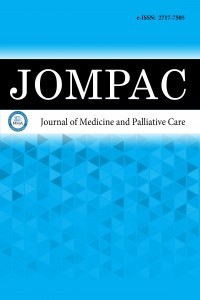1.
Kaçmaz H. Approach to acute gastrointestinal bleeding. In:Serdar Olt, eds. Health&Science: Internal Medicine Emergencies.Efeakademi Publishing. 2022:151-160.
2.
Nkurunziza L, Bacha H, Gharbi T, Benzzoubeir N, Errabih I.Upper gastrointestinal bleeding:a prospective epidemiologicalstudy about 72 cases and review of the literature. SJMPS.2022;8(7):319-326. doi:10.36348/sjmps.2022.v08i07.001
3.
Rodrigues A, Carrilho A, Almeida N, et al. Interventionalalgorithm in gastrointestinal bleeding-an expert consensusmultimodal approach based on a multidisciplinary team. Clin ApplThromb Hemost. 2020;26:1-19. doi:10.1177/1076029620931943
4.
Luo PJ, Lin X-H, Lin C-C, et al. Risk factors for uppergastrointestinal bleeding among aspirin users: an old issue withnew findings from a population-based cohort study. J FormosMed Assoc. 2019;118(5):939-944. doi:10.1016/j.jfma.2018.10.007
5.
Panchal NK, Sabina EP. Non-steroidal anti-inflammatory drugs(NSAIDs):A current insight into its molecular mechanismeliciting organ toxicities. Food Chem Toxicol. 2023;172:113598.doi:10.1016/j.fct.2022.113598
6.
Bahraini A, Koneri R. Prescription pattern analysis ofnonsteroidal antiÿ inflammatory drugs in the SoutheasternKarnataka population, India. APP. 2021;11(1):116-119.
7.
Hosnia M, Rahala M, Tamimb H, et al. Increased rebleedingand mortality in patients with gastrointestinal bleeding treatedwith anticoagulant drugs compared to antiplatelet drugs. EurJ Gastroenterol Hepatol. 2021;33(1):e490-e498. doi:10.1097/MEG.0000000000002148.
8.
Alshammri MR, Altamimi NO, Dera RM, et al. The use of overthe counter aspirin as prophylaxis for cardiovascular diseasesamong adult people in Saudi Arabia. Med Sci. 2022;26:136e2155.doi:10.54905/disssi/v26i122/ms136e2155
9.
García Rodríguez L, Lanas A, Soriano-Gabarró M, Vora P, CeaSoriano L. Effect of proton pump inhibitors on risks of upper andlower gastrointestinal bleeding among users of low-dose aspirin:apopulation-based observational study. J Clin Med. 2020;9(4):928.doi:10.3390/jcm9040928
10.
Awuchi CG. Medicinal Plants:the medıcal, food, and nutrıtıonalbıochemıstry and uses. IJAAR. 2019;5(11):220-241. doi:10.46654/ij.24889849
11.
Banerjee S. Safety concerns of dietary and herbal supplementsfor typical patients. Int J Pharm Chem Anal. 2021;8(4):141-144.doi:10.18231/j.ijpca.2021.027
12.
Abebe W. Review of herbal medications with the potential tocause bleeding:dental implications, and risk prediction andprevention avenues. EPMA J. 2019;10(1):51-64. doi:10.1007/s13167-018-0158-2.
13.
Dağlar N, Dağdeviren HN. The place of phytotherapy intraditional and complementary medicine applications. Euras JFam Med. 2018;7(3):73-77.
14.
Demirtaş Z, Dağtekin G, Sağlan R, et al. Validity and reliabilty ofrational drug use scale. ESTÜDAM J Public Health. 2018;3(3):37-46.
15.
Köse E, Ekerbiçer HÇ, Erkorkmaz Ü. Complementary, alternativeand conventional medicine attitude scale: Turkish validityreliability study. Sakarya Med J. 2018;8(4):726-736. doi:10.31832/smj.478148
16.
Oral S. Information and behavior of patients about rationaldrug use. Abant Med J. 2021;10(3):330-344. doi:10.47493/abantmedj.2021.870503.
17.
Apaydın M. Investıgatıon of the knowledge and attıtudesregardıng ratıonal drug use, and affectıng factors of adults whoapply to an internal medıcıne outpatıent In: Bahçecik N. MasterThesis. İstanbul. 2022
18.
Kuyifatih A, Yenimahalleli YG, Günaltay MM. Rational drug use:an application in Ankara University Faculty of Health Sciences.FSECON. 2022;6(1):251-277. doi:10.25295/fsecon.1040173.
19.
Acar AB, Özen M. Evaluation of aspirin use in patients admittedto the family medicine outpatient clinic. Cukurova Med J.2021;46(3):1026-1032. doi:10.17826/cumj.907395
20.
Soriano LC, Lanas A, Soriano-Gabarró M, Garcia RodriguezLA. Incidence of upper and lower gastrointestinal bleedingin new users of low-dose aspirin. Clin Gastroenterol Hepatol.2019;17(5):887-895. doi:10.1016/j.cgh.2018.05.061
21.
Biçer İ, Yalçın Balçık P. Tradıtıonal and complementarymedıcıne:investıgatıon of Turkey and the selected countrıes.Hacettepe J Health Administration. 2019;22(1):245-257.
22.
Özer Z, Turan G.B, Bakır E. Attitude of patients admittedto internal diseases polyclinic towards conventional andcomplementary medicine and the affecting factors. J Health ProRes. 2020;2(3):102-112.
23.
Foley H, Steel A, Cramer H, Wardle J, Adams J. Disclosure ofcomplementary medicine use to medical providers: a systematicreview and meta-analysis. Sci Rep. 2019;9(1):1573. doi:10.1038/s41598-018-38279-8.
24.
Solak Y, Kaya E, Yoldaşcan BE. Knowledge and attitudes aboutherbal products and herbal medicine in people applying to familyhealth care center. Fırat Med J. 2020;25(4):213-218
25.
Barlin D, Ercan A, Conditions of use of food and vegetableproducts in the adults having digestive system problems. Turk JAcad Gastroenterol. 2020;19(1):31-37. doi:10.17941/agd.708506
26.
Carlsson JM, Vestin M, Bjerså K. Use of complementary andalternative medicine (CAM) among emergency department(ED) patients in Sweden. BMC Complementary Med Ther.2020;20(1):327. doi:10.1186/s12906-020-03126-9
27.
Şensoy N, Özdinç Ş, Yılmaz O, et al. The attıtudes and behavıors ofpatıents admıtted to unıversıty hospıtal towards complementaryand alternatıve therapies. Kocatepe Med J. 2020;21(3):258-263.doi:10.18229/kocatepetip.676401
28.
Çavuşoğlu M, Yılmaz M. Attitudes and behaviors of migratedpeople from bulgaria regarding traditional and complementarytherapy methods. JPHN. 2020;2(2):57-72.
29.
Kaur J, Hamajima N, Yamamoto E, et al. Patient satisfactionon the utilization of traditional and complementary medicineservices at public hospitals in Malaysia. CTIM. 2019;42:422-428.doi:10.1016/j.ctim.2018.12.013

